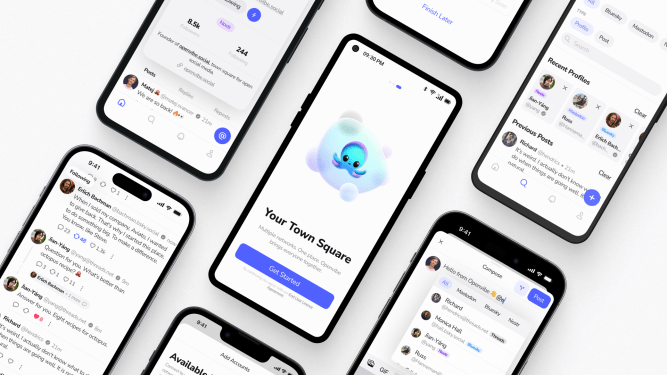News that X (formerly Twitter) is now valued internally at $19 billion has unleashed a wave of snickering from critics of Musk and his recently renamed social network. So instead of discussing why X may have shed so much value since it was purchased, including the caveat that it was not worth the $44 billion Musk paid when he bought it, let’s do a bit of comparison this morning.
The Exchange explores startups, markets and money.
Read it every morning on TechCrunch+ or get The Exchange newsletter every Saturday.
Snap, another social network company with its own share of ups and downs, reported its third-quarter financial results a week ago. As of this morning, it’s worth $15.97 billion, according to Yahoo Finance data, which is sort of close to X’s new internal valuation.
 Fans of both Snap and X could detail a host of differences between the two services, but they also have similarities. Both are smaller social networks in a world dominated by Meta; they’ve been through difficult times lately with revenue dipping; both have a subscription product and big ads businesses, and both are focused on mobile. More importantly, they each carry significant debt.
Fans of both Snap and X could detail a host of differences between the two services, but they also have similarities. Both are smaller social networks in a world dominated by Meta; they’ve been through difficult times lately with revenue dipping; both have a subscription product and big ads businesses, and both are focused on mobile. More importantly, they each carry significant debt.
So, let’s peek at Snap’s Q3 numbers and see if we can find out whether X’s new valuation is reasonable, inexpensive or ambitious. To work!
A snapshot of Snap’s results
Snap’s revenue declined in the first two quarters of the year, but the company returned to growth in Q3, with its top line rising 5% to $1.19 billion from a year earlier.
When you look at the bottom line, Snap remains a two-story concern. On the GAAP side of things, the company is immensely unprofitable. Its Q3 2023 net loss of $368.3 million was nearly unchanged from a year ago, though its operating loss in its most recent period ($380.1 million) was narrower than in Q3 2022 ($435.2 million).
But if we use more generous accounting techniques, Snap is just about profitable. It managed adjusted EBITDA of $40.1 million in Q3 2023 — that’s 45% less the $72.6 million it reported a year ago, but it’s still in the black. The company also posted positive operating cash flow ($12.9 million compared to $55.9 million a year ago), but its free cash flow went negative in the third quarter, which isn’t so nice.
Still, Snap expects a much stronger quarter to end the year, loosely forecasting Q4 revenue between $1.32 billion and $1.375 billion, which would imply revenue growth of about 2% to 6%. It also expects adjusted EBITDA between $65 million and $105 million, all predicated on reaching 410 million to 412 million daily active users. Snap closed Q3 with 406 million DAUs, for reference.
All that is worth about $16 billion.
So, what do we know about X?
- June 2023 (NYT): “Twitter’s U.S. advertising revenue for the five weeks from April 1 to the first week of May was $88 million, down 59 percent from a year earlier, according to an internal presentation obtained by The New York Times.”
- July 2023 (Reuters): “Twitter’s cash flow remains negative because of a nearly 50% drop in advertising revenue and a heavy debt load, Elon Musk said on Saturday, falling short of his expectation in March that Twitter could reach cash flow positive by June.”
- July 2023 (The Guardian): “It is unclear what timeframe Musk was referring to by the 50% drop in ad revenue. He has said Twitter was on track to post $3bn in revenue in 2023, down from $5.1bn in 2021.”
- October 2023 (Reuters): “Monthly U.S. ad revenue at social media platform X has declined at least 55% year-over-year each month since billionaire Elon Musk bought the company formerly known as Twitter in October 2022, according to third-party data provided to Reuters.”
How many people are using X? Third-party data has struck a negative note and X itself has worked to put a positive spin on things. That said, it doesn’t seem likely that X is much bigger than Snap in DAU terms, if it is larger at all.
X seems to be on track to record revenue of around $3 billion this year, which makes its revenue base a lot smaller than Snap’s. Through Q3 2023, Snap had revenue of $3.24 billion, which puts it on track to clock more than $4.5 billion this year. That’s 50% more than what X expects. What’s more, Snap is growing its top line again and has been reporting better audience metrics, too.
In a nutshell, then: Snap is looking like the better company thus far.
It may also be doing better in subscription terms. Snapchat+ reached 5 million subscribers in the third quarter, up from the more than 4 million it reported in Q2 2023. It’s not clear how many X Premium (formerly known as Twitter Blue) subscribers exist, but data reported by various media outlets puts the number in the six figures, which would make it far smaller than Snap’s subscriber base. Even if all these reports are wrong by a factor of four, X is still far behind what Snap has in its pocket, at least in terms of the number of subscribers (notably: Snapchat+ is cheaper than X Premium).
Then there’s profitability. It isn’t a huge shock to see that X was cash-flow negative earlier this year given the company’s massive debt load. Snap, too, has lots of debt, with $3.75 billion of senior convertible notes alone. X, however, took on $13 billion worth of debt. Sure, that gives it a much larger enterprise value, but that’s not really what we’re looking for today. Snap, with its lower debt levels, looks healthier.
So, Snap has more revenue, is growing, has a similar number of users (if not more), and has more paid subscribers. From that perspective, it’s hard to understand why X thinks it’s worth $19 billion while the market is valuing Snap at a more modest $16 billion.






